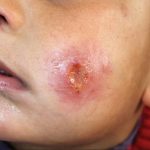 A disease caused by protozoan parasites that belong to the genus Leishmania and is transmitted by the bite of certain species of sand fly.
A disease caused by protozoan parasites that belong to the genus Leishmania and is transmitted by the bite of certain species of sand fly.
Infection with Leishmania, a parasitic protozoa.
A disease caused by the parasite Leishmania, one form of which causes disfiguring ulcers, while another attacks the liver and bone marrow.
Infection, most common in warm climates, with protozoa of the genus Leishmania; it occurs in two forms: visceral and cutaneous, affecting skin tissues. Treatment often involves the use of antibiotic agents.
A parasitic infection spread by the bite of certain types of phlebotomine sand flies. Leishmaniasis, also called kala-azar, occurs most commonly in rural areas of countries ranging from Central America to western Asia; the infection is rare in the United States, but residents in rural Texas have developed a form of the infection. Also, US troops in the second Gulf War in the 2000s reportedly contracted this infection. The parasite attacks the body’s phagocytes, the “hunter-killer” cells in the immune system.
A disease, common in the tropics and subtropics, caused by parasitic protozoans of the genus Leishmania, which are transmitted by the bite of sandflies. There are two principal forms of the disease: visceral leishmaniasis, in which the cells of various internal organs are affected; and cutaneous leishmaniasis, which affects the tissues of the skin. Cutaneous leishmaniasis itself has several different forms, depending on the region in which it occurs and the species of Leishmania involved. In Asia it is common in the form of oriental sore. In America there are several forms of leishmaniasis. Leishmaniasis is usually treated with drugs containing antimony.
A group of infections caused by parasites transmitted to humans by sandflies.
A group of related chronic parasitic diseases of the skin, viscera, or mucous membranes, caused by species of the genus Leishmania, which are transmitted to humans by the bite of tiny, infected female sandflies, 30 different species of which thrive in both tropical and temperate regions and carry Leishmania. Leishmaniasis has been known to occur in epidemics but occurs mostly as an endemic disease in Asia, Africa, Latin America, and the Middle East; U.S. military personnel may be infected during overseas operations. One type of leishmaniasis, kala azar, causes visceral infection and involves the mononuclear phagocytic system, causing inflammation and fibrosis of the spleen and liver. It can be fatal if untreated. Mucosal leishmaniasis infection produces mutilating lesions that destroy the mucosa, esp. in the larynx, anus, and vulva. In the two cutaneous forms of leishmaniasis, multiple skin ulcers form on exposed areas of the face, hands, arms, and legs. While these are not painful or contagious, if left untreated they can leave permanent, disfiguring scars. Leishmania organisms infect and reproduce inside macrophages and are controlled by T-cell-mediated response. The strength of the patient’s immune system determines the severity of the disease.
Several diseases stem from single-celled parasites known as leishmania. These parasites are hosted by dogs and rodents, and their transmission occurs through the bites of sandflies.
The gravest variant of leishmaniasis is known as kala-azar or visceral leishmaniasis. This affliction is widespread in specific regions of Asia, Africa, and South America, and is also found in certain Mediterranean nations. Furthermore, diverse forms of cutaneous leishmaniasis exist, with some prevalent in the Middle East, North Africa, and the Mediterranean region.
Kala-azar leads to a continuous fever, spleen enlargement, anemia, and eventually, skin darkening. The disease can manifest within a two-year period following infection, and if not treated, it can result in death. The cutaneous variations of the ailment present as a lasting ulcer at the location of the sandfly bite.
Different forms of leishmaniasis can be effectively managed using medications, such as sodium stibogluconate, administered through intramuscular or intravenous injections.
Individuals traveling to regions where leishmaniasis is prevalent should adopt precautions to reduce the likelihood of being bitten by sandflies.
Infection resulting from protozoa belonging to the Leishmania genus can manifest in various clinical forms, with several distinct species responsible for these differing presentations.
